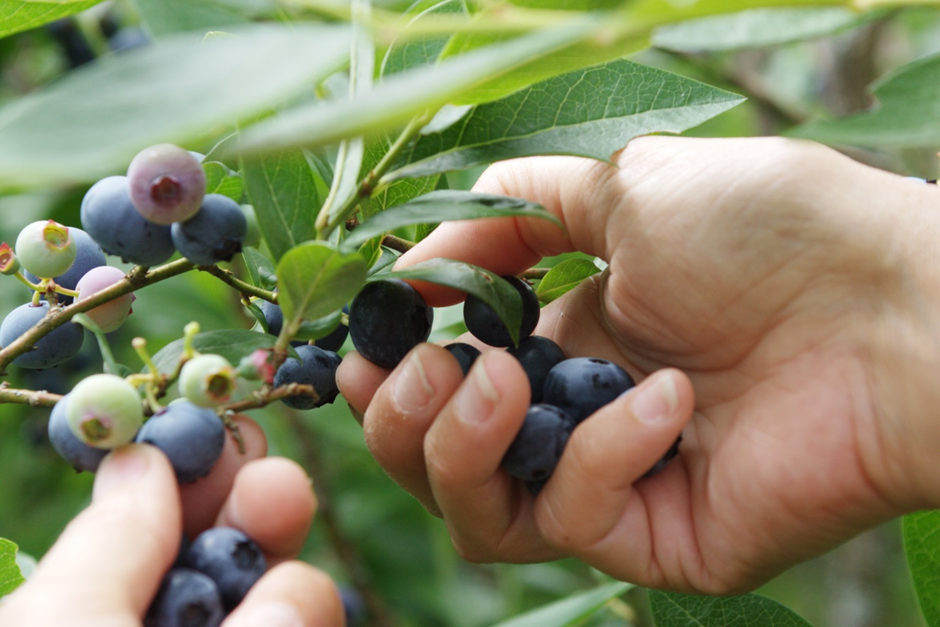Production and consumption statistics in recent years clearly show that blueberries are more at home in their native North America than anywhere else in the world. However, the growing and selling of blueberries is fast becoming a significant commodity in Australia too, providing an increasing number of seasonal jobs.

Blueberries – late bloomers in Australia
As any Canadian or American backpacker can tell you, blueberries have become a staple item in shopping baskets at home. However, home-grown blueberries in Australia are becoming more common and are providing many work opportunities.
Around 90% of all Australian blueberries are grown in NSW, and production is mainly in the north eastern corner of the State. Three districts dominate: Woolgoolga, just north of Coffs Harbour, has a large number of small family farms, plus the nearby enormous Berry Exchange farm operated by the Costa group. Further north the Clarence Valley has several large new farms, and the Richmond Valley also supports several smaller farms as well.
Where does Australia fit on the world blueberry scene?
Despite the huge increase in plantings and production across the last decade or so, Australia’s production pales in comparison to our friends on the North American continent, who currently provide over half the world’s supply. In 2018, the USA produced over 250,000 tonnes of blueberries and Canada around 164,000 tonnes, while last year Australia grew less than 20,000 tonnes. And while we are expanding from that low baseline, other producing nations are doing the same.
A labour intensive crop
The big opportunity for travelling workers is that virtually all blueberries in the Australian context are grown for fresh consumption and so are picked by hand. Blueberry bushes are generally grown on low mounds and the bushes are usually less than two metres tall, so picking into small buckets strapped to the waist is not difficult. There are no ladders to climb, no need to carry heavy bags over the shoulders, and a lot of production is under tunnels or nets where exposure to the weather is minimised.
Regional Development Australia estimates that around 5,000 seasonal workers, mainly pickers, are required in Northern NSW alone, and visa holders make up a very large proportion of that workforce. The majority of farms in this region have the advantage of being on the backpacker trail from Sydney to the Queensland beaches. Byron Bay is a very prominent and popular youth tourism location and is right in the heart of blueberry country, which means there are plenty of work opportunities not far away. A commitment from a potential worker to stay at least a few months, and be reliable and punctual, are the critical characteristics to convince an employer to take someone on.
Longer season – more work options
As new, earlier-maturing varieties of berries are now in production in Northern NSW. The earliest picking in NSW can start in June, and working days are likely to be intermittent until the season fully kicks in a month or so later. Full production, when the biggest numbers of workers are needed, continues through Winter and Spring and tapers down to completion early in the New Year.
However labour requirements are not stable and consistent over the season. Farms may need to top-up the workforce at peak times and to relieve themselves of excess workers in the quieter times, which means there are opportunities as the season progresses, not just for those at the start.
Virtually all picking is paid by piece-rates in the blueberry industry, and can vary daily depending on the maturity, size, and yield of each particular patch of fruit to be harvested. Generally, the piece-rates offered are fair, and as the work is physically undemanding, even inexperienced backpackers can make good money with reasonable effort.
Pruning of the bushes starts immediately after harvest and can take place over several months, providing work for an even longer period. However there are far fewer positions available than with picking. This work is usually paid hourly, and is likely to only be offered to workers who have proven themselves to be the most reliable and productive pickers.
Some farms also have packing sheds which provides another avenue for hourly paid work. Shift work is not uncommon during the peak of the season in the sheds, and although locals are often preferred for packing work, travelling workers will also be considered.
In the cool south as well
Although the warm regions of NSW dominate blueberry production, there are still significant plantings in the cooler parts of that state, and also in Victoria. But Tasmania appears to be the big mover with new large-scale developments supplementing smaller existing family operations, to continue to provide fruit once the northern harvest is complete. For an industry that didn’t really exist in the Tasmania until just over a decade ago, it has expanded in leaps and bounds since and growth is continuing.
Costa’s Berry Exchange has established a large growing operation near Penguin on the north coast of Tasmania, to complement their NSW property just north of Coffs Harbour. Once harvest winds down in the earlier northern region, they transfer good workers south to their Tasmanian operation, so there is an opportunity to continue to earn while seeing another, quite different part of Australia.
In the cooler summer conditions blueberries usually start in December and are complete by late February. Most farms in Tasmania with blueberries have other berries as well, which extends working opportunities either side of the blueberry harvest.
